Rejuvenate Your Skin: Unlocking the Power of Microneedling to Treat Acne Scars
Microneedling is a minimally invasive cosmetic procedure that has gained popularity for its effectiveness in treating acne scars on the skin. The process involves the use of a device with fine needles that create tiny, controlled punctures in the skin’s surface and skin tissue.


These micro-injuries stimulate the body’s natural healing processes, promoting the production of collagen and elastin-essential proteins for skin structure and elasticity. The microneedling procedure for acne scars begins with the application of a topical numbing cream to ensure patient comfort.
The depth of needle penetration can be adjusted based on the specific acne scarring type and location. Once the skin is prepped, the microneedling device is gently rolled or stamped over the scarred area, creating thousands of microscopic channels. As the needles penetrate the skin, they trigger a controlled inflammatory response. This response signals the body to repair the damaged tissue, increasing collagen production and making the skin smoother.
Collagen is crucial for maintaining skin strength and resilience, and its enhanced production helps to smooth out scars and improve overall skin texture. Microskin needling is particularly effective for treating atrophic acne scars, surgical scars, and other types of atrophic scars. The procedure can be performed on various areas of the body, including the face, neck, and hands, even on stretch marks. Additionally, microneedling therapy is suitable for all skin types and tones.
The recovery time after microneedling to treat acne scars is relatively short, with most patients experiencing mild redness and swelling for a day or two.
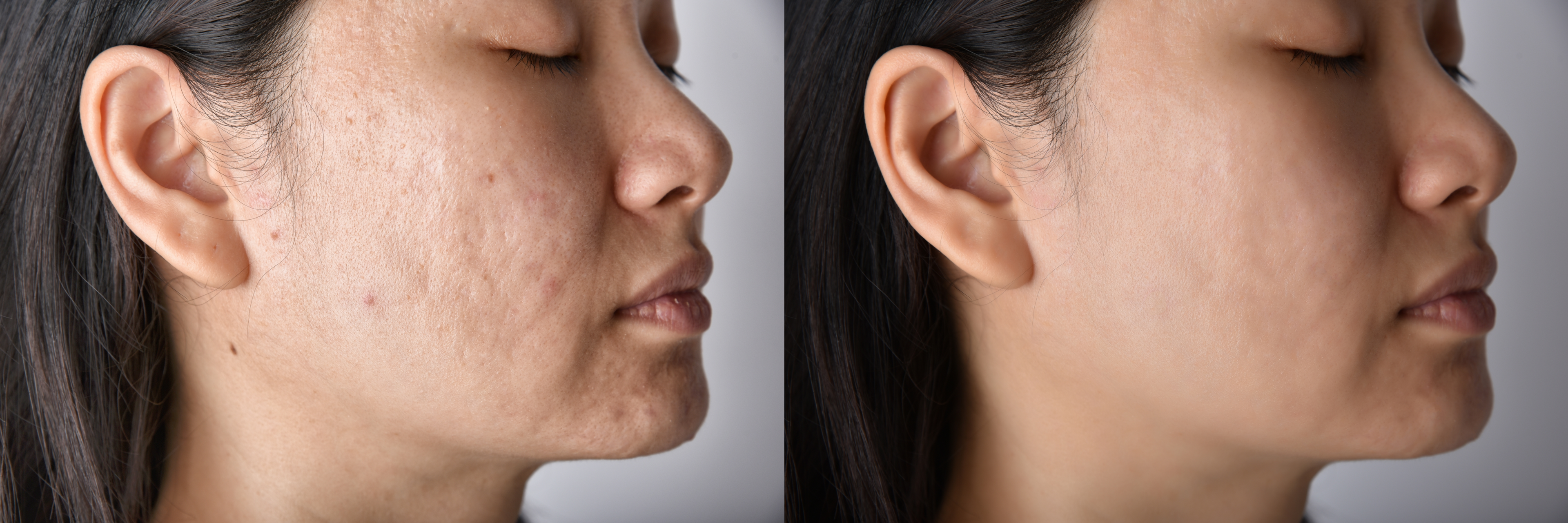

Over the following weeks, as the collagen production continues, the skin gradually improves in texture and appearance. A series of sessions may be recommended for optimal results, spaced a few weeks apart. It is important to note that microneedling as a treatment for acne scarring should be performed by trained professionals in a clinical setting to ensure safety and efficacy.
As with any aesthetic treatment, individual results may vary, and consultation with a healthcare provider is essential to determine the most suitable and alternative treatment plan for specific scar types and skin conditions. The application of microneedling involves several key steps to ensure safety and efficacy in treating scars of severe acne on the skin. Here’s a more detailed breakdown of the process:
- Consultation and assessment. Before undergoing microneedling, individuals typically have a consultation with a qualified skincare professional or dermatologist. During this consultation, the practitioner assesses the types of scars, skin conditions, and medical history of active acne to determine the treatment options.
- Preparation of the skin. On the day of the procedure, the targeted area is thoroughly cleansed to remove any makeup, oils, or debris. A topical cream is then applied to minimize discomfort during the microneedling process.
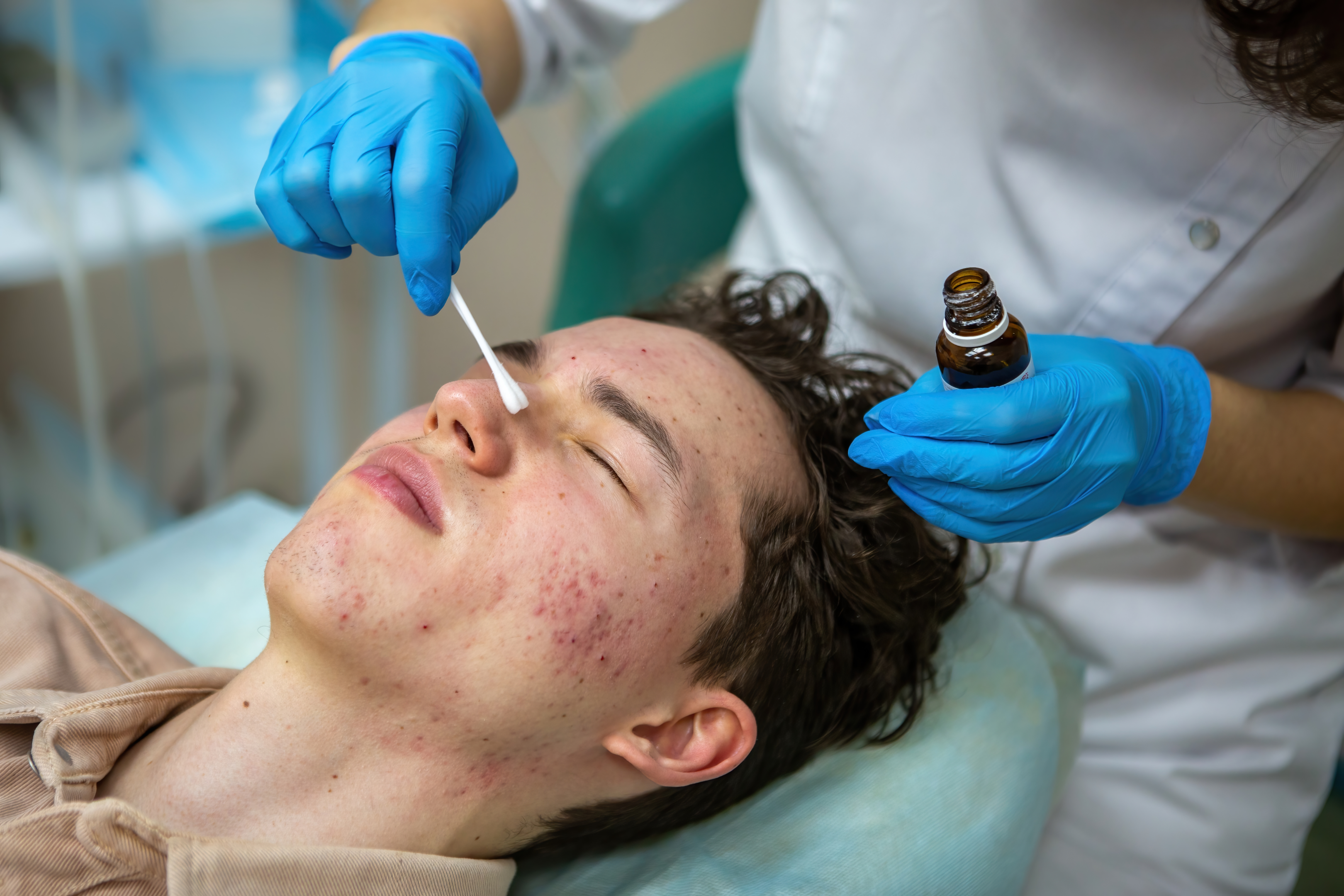

- Microneedling Device Selection. Microneedling can be performed using various devices, such as derma rollers or motorized pens equipped with tiny needles. The choice of the device depends on the specific requirements of the treatment and the practitioner’s preference.
- Needle Depth Adjustment. The depth of the tiny needle penetration is adjusted based on the type and location of the scars. Some scar tissue may require more extended needle penetration, while more superficial scars or delicate areas may need shallower settings.
- Microneedling Procedure. The practitioner then systematically moves the microneedling device over the skin, creating controlled micro-injuries to promote skin healing. The device may be rolled or stamped, depending on the treatment modalities. The procedure is performed with precision to ensure even coverage of acne scars and optimal results.
- Post-Procedure Care. After microneedling, patients may experience mild redness in the treatment area and swelling resembling a sunburn. The treatment area is typically soothed with a cool compress, and patients are advised to avoid sun exposure and use gentle skincare products in the days following the procedure.
- Recovery period. The recovery time varies, but most individuals can resume regular activities within a day or two. The skin may continue to improve over several weeks of collagen stimulation production.
- Multiple Sessions. While some individuals may see improvement after a single session, a series of microneedling procedure sessions spaced several weeks apart is often recommended for optimal results. The number of sessions depends on the severity of the scars if there are acne breakouts, cystic acne, or depressed acne scars, and the desired outcome.
- Post-treatment Follow-up. Follow-up appointments allow the practitioner to assess the progress, address any concerns, and adjust the treatment plan if necessary. Skincare recommendations, including the use of sunscreen, are often provided to support long-term results.
- Maintenance and Results. Skin needling can provide long-lasting results, but maintenance sessions may be recommended periodically to sustain the benefits. Patients often notice a gradual improvement in skin texture, reduced scar visibility, skin rejuvenation, and an overall enhancement in skin quality.
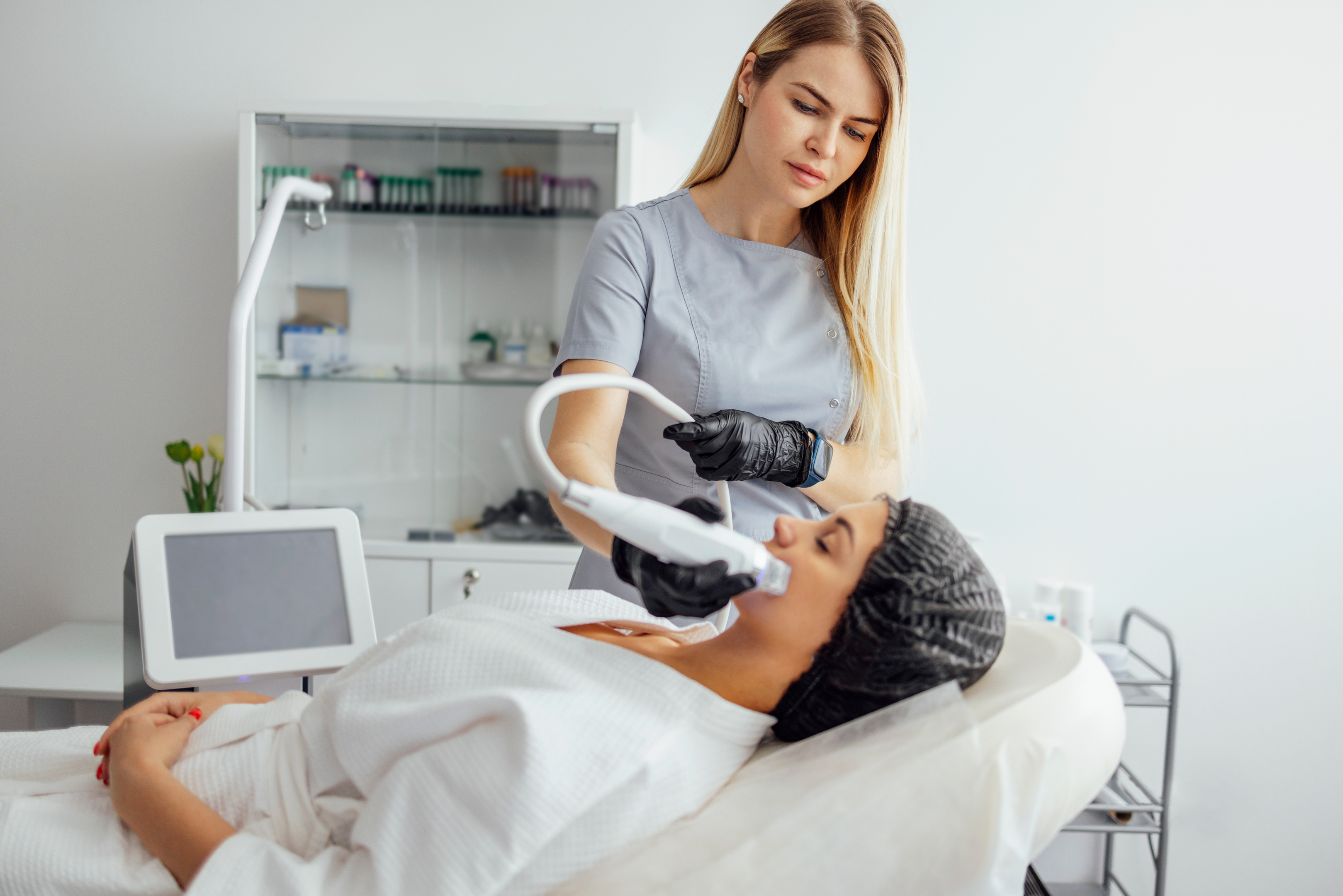

- Potential Side Effects. While microneedling is generally safe, individuals may experience mild side effects such as redness, swelling, and minor discomfort. Serious complications are rare when the procedure is performed by a trained professional in a sterile environment.
Microneedling is considered a good option for the treatment of acne and acne scars due to several reasons:
- Stimulates Collagen Production. Acne can leave behind atrophic scars, which are caused by the loss of collagen in the skin. Microneedling stimulates collagen, a crucial protein that helps to restore skin structure and elasticity. By promoting collagen formation, microneedling can improve the appearance of acne scars.
- Reduces Scar Depth and Texture Irregularities. The controlled micro-injuries created by microneedling treatments for acne scars encourage the skin to heal and regenerate. As a result, the depth of acne scars can be reduced, and the overall texture of the skin becomes smoother. This makes microneedling effective for addressing both pitted and raised acne scars.
- Enhances Absorption of Topical Treatments. Microneedling creates tiny channels in the skin, improving the absorption of topical treatments. This is particularly beneficial when combining microneedling therapy with serums or growth factors that further support collagen production and skin regeneration.
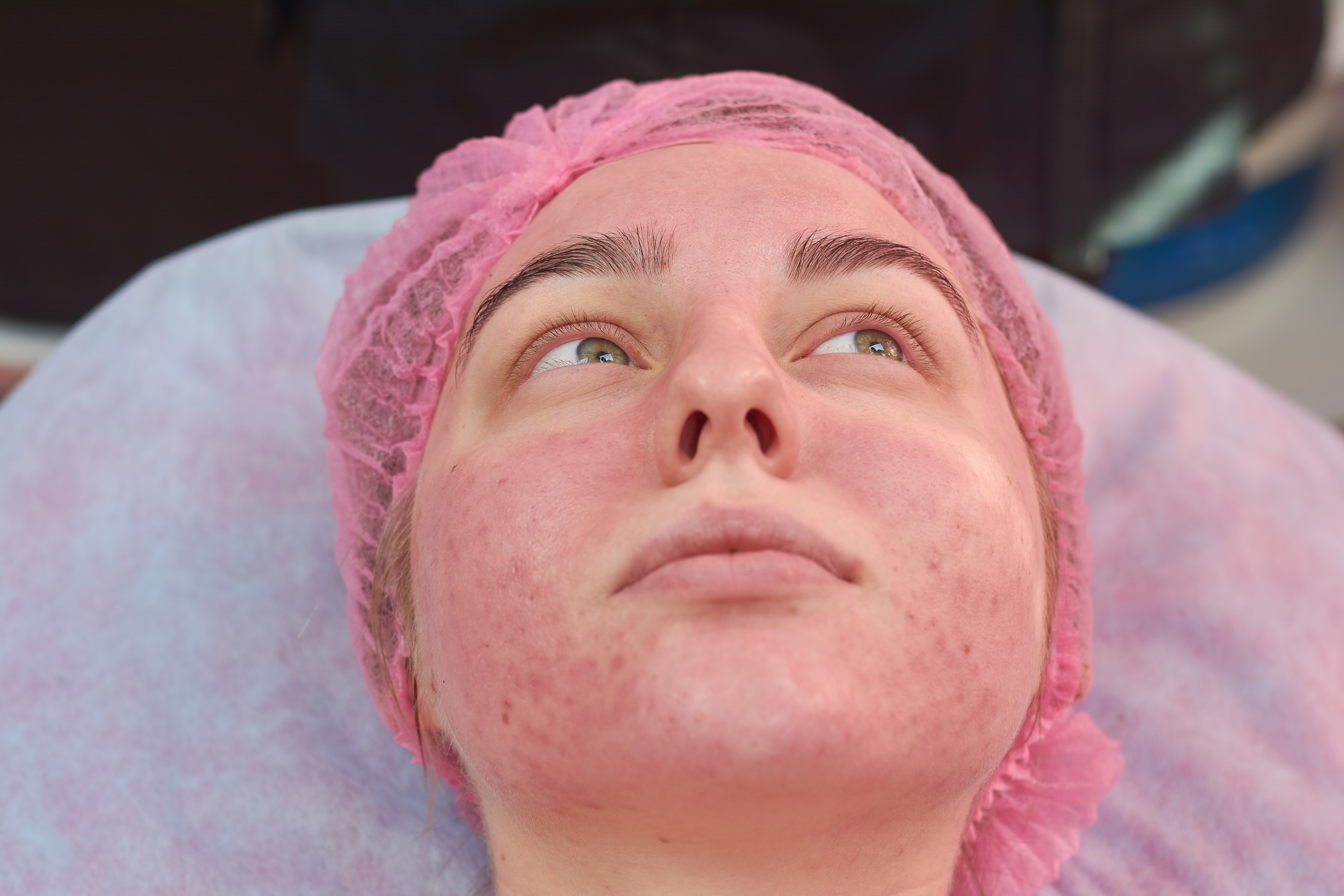

- Minimally Invasive with Minimal Downtime. Compared to more invasive procedures, microneedling is a minimally invasive treatment with relatively minimal downtime. Patients typically experience mild redness and swelling for a day or two, making it a convenient option for those with busy schedules.
- Versatility for various Acne Scars. Microneedling is versatile and can be tailored to address different types of acne scars, including ice-pick scars, boxcar scars, and rolling scars. The depth of needle penetration can be adjusted based on the specific needs of each patient.
- Safe for Different Skin Types. Microneedling is generally safe for individuals with various skin types and tones. Unlike certain laser treatments, which may carry a risk of pigmentation changes in darker skin, microneedling poses a lower risk of causing hyperpigmentation or hypopigmentation.
- Improves Overall Skin Quality. Beyond scar treatments, microneedling contributes to overall skin rejuvenation. It can improve skin tone, reduce fine lines, and enhance the overall quality of the skin. This makes it a comprehensive option for individuals looking to address multiple skin concerns simultaneously.
- Customizable Treatment Plans. Treatment plans can be customized based on the severity of acne scars and individual patient goals. A series of sessions may be recommended, and the depth of microneedling can be adjusted progressively as the skin responds to the treatment.
- Long-Lasting Results. While individual results may vary, many individuals experience long-lasting improvements in the appearance of acne scars with microneedling. Periodic maintenance sessions may be recommended to sustain the benefits over time.
- It’s important to note that the effectiveness of microneedling for acne scars can vary from person to person. Consultation with a qualified skincare professional or a board-certified dermatologist is essential to determine the suitability of microneedling based on individual skin conditions and goals.
How much does the microneedling for acne scars cost in Mexico?
The cost of microneedling for acne scars in Tijuana, Mexico, can vary depending on several factors, including the clinic or spa, the experience of the practitioner, the specific areas being treated, and whether additional treatments or serums are included. However, in Mexico, cosmetic procedures, including microneedling, are often more affordable compared to prices in some other countries.
On average, microneedling sessions can range from $50 to $150 USD per session, but this is a general estimate, and costs can vary. It is important to consider that while cost is a factor, the qualifications and reputation of the practitioner, as well as the hygiene and safety standards of the facility, should be top priorities. Ensure that the practitioner performing the microneedling is a licensed professional with experience in the procedure.
Before undergoing any cosmetic procedure, it’s advisable to schedule a consultation with the chosen provider to discuss your specific needs, assess the condition of your skin, and receive a personalized quote. Additionally, inquire about any potential additional costs, such as post-care products or follow-up appointments. Always choose a reputable and certified clinic or spa for cosmetic procedures, and take the time to research reviews and testimonials from other patients who have undergone similar treatments in the same facility. Remember that individual responses to microneedling for acne scars can vary, so results and the overall experience may differ from person to person.
How many microneedling sessions does it take to get rid of acne scarring?
The number of microneedling sessions required to effectively reduce or eliminate acne scarring can vary based on several factors, including the type and severity of the scars, individual skin response, and the specific goals of the patient. Generally, a series of sessions is recommended to achieve optimal results. Many practitioners suggest a course of three to six sessions spaced approximately four to six weeks apart. However, it is crucial to note that visible improvements may be noticeable even after the first session, with continued enhancement over subsequent sessions for acne scar treatments.
Factors influencing the number of microneedling sessions include:
- Type of scars. The type of acne scars, such as ice pick scars, boxcar scars, or rolling scars, can impact the treatment plan. Deeper scars may require more sessions for noticeable improvement.
- Skin Type and Response. Individual skin types and responses to microneedling vary. Some individuals may experience faster and more significant improvements, while others may require more sessions for noticeable changes.
- Treatment Depth. The depth of needle penetration during microneedling can be adjusted based on the specific needs of the patient and the type of scars being treated. Deeper treatments may produce more dramatic results but may require more recovery time.
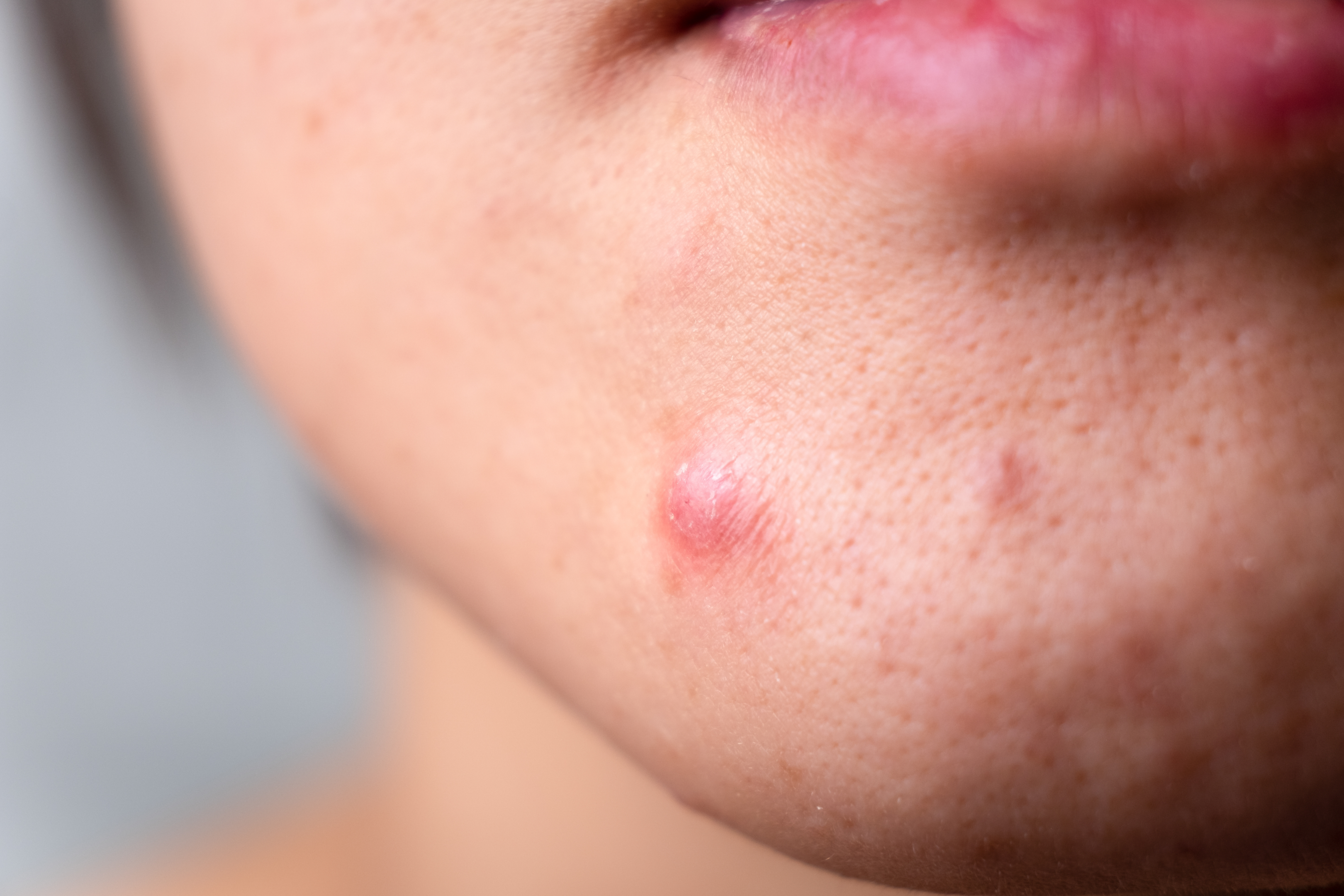

- Combination with Other Treatments. Microneedling for acne scars is often combined with other treatments, such as topical serums or platelet-rich plasma (PRP), to enhance results. The inclusion of additional treatments may impact the overall number of sessions needed.
- Individual Goals. Patients’ goals play a role in determining the number of sessions. Some individuals may be satisfied with modest improvements, while others may pursue more extensive treatments for more patient satisfaction. It is essential to have realistic expectations about the outcomes of microneedling. While the procedure is effective in reducing the appearance of scars, complete elimination may not always be possible. This type of treatment does not avoid post-acne breakouts or future cystic acne.
Consulting with a qualified skincare professional or dermatologist is crucial for an accurate assessment of your specific case and for establishing a personalized treatment plan. They can provide guidance on the number of sessions needed based on your skin condition and desired results.
How long does microneedling take to work on acne scars?
The timeline to seeing noticeable results of an effective treatment from microneedling on acne scarring can vary from person to person. Generally, individuals may begin to observe improvements in the appearance of their atrophic acne scars in the weeks and months following the initial treatment. Here’s a general timeline:
- Immediate Effects. After a microneedling session for acne scars, some individuals may experience a subtle improvement in skin texture and a temporary glow due to increased blood flow. However, the most significant changes typically occur over time as the skin’s natural healing process is activated.
- Initial Weeks. In the first weeks following microneedling for acne scars, patients may notice a reduction in redness and inflammation. The skin may appear smoother as the initial healing response takes place.
- First Month. New collagen production is stimulated in the weeks following microneedling. Contributing to improvements in the skin texture and the reduction of superficial acne scars. The skin may continue to appear more even and radiant.
- Continued Improvement. Over the next several months, collagen remodeling continues, leading to further refinement of the skin’s texture. Deeper scars may also show gradual improvement during this period.
- Optimal Results. The optimal results from microneedling are typically seen around to three to six months after the initial treatment. This is the time it takes for the collagen synthesis and remodeling processes to reach their peak.
It is important to note that individual responses to skin needling can vary, and multiple sessions may be recommended to achieve the desired results. The specific type and severity of acne scars, as well as the depth of the microneedling treatment, can influence the timeline for improvement.
Additionally, some individuals may choose to undergo a series of microneedling sessions spaced several weeks apart to maximize the benefits. The cumulative effects of multiple sessions can lead to more significant and long-lasting improvements in the appearance of acne scars.
Regular follow-up appointments with the skincare professional or dermatologist are essential to assess progress, adjust the treatment plan if necessary, and address any concerns. Patience is key, as the full benefits of microneedling may take time to manifest, and results continue to improve over an extended period after the completion of the treatment series.
Will acne scars come back after microneedling as an acne scarring treatment?
Microneedling for acne scars can provide effective and long-lasting improvements in the appearance of acne scars, but it’s important to understand that the procedure doesn’t guarantee permanent removal of acne scars, and in some cases, new scars may form due to factors such as ongoing acne or other skin conditions. The longevity of results after microneedling can be influenced by several factors.
If the root cause of acne or other skin conditions persists, new scars may form over time. Microneedling addresses existing scars but may not prevent the development of new ones or a new acne breakout.
Proper skincare after microneedling is crucial for maintaining results. Following a recommended skincare routine, using sun protection, and avoiding factors that can contribute to skin damage are essential in preventing the recurrence of acne scarring.
Factors such as sun exposure, smoking, and poor skincare habits can impact the longevity of microneedling results. Protecting the skin from harmful UV rays and adopting a healthy lifestyle can contribute to sustained improvement. Also, these lifestyle factors may influence the appearance of new acne breakouts, avoiding the developed scars or getting moderate acne scars.
The individual’s healing response and how well their skin retains collagen can affect the long-term outcome. Some individuals may experience more prolonged benefits, while others may require periodic maintenance sessions to sustain results. The depth and intensity of microneedling for acne scars treatments can influence the longevity of results. Deeper treatments may provide more dramatic improvements but could also require more recovery time.
While microneedling can produce enduring results for many individuals, it is essential to manage expectations and recognize that maintenance may be necessary, especially in cases where underlying factors like acne continue to impact the skin. Regular Follow-Up appointments with a professional or dermatologist can help monitor the skin’s conditions, address any emerging concerns, and determine whether additional microneedling sessions or other treatments are needed to maintain or enhance results.
Additionally, adopting a comprehensive approach to skincare, including a healthy lifestyle and proper skincare practices, can contribute to the long-term success of microneedling in managing acne scars.
Which microneedling is best for acne scars?
Several microneedling devices and techniques are used for the treatment of acne scars, and the effectiveness can depend on various factors, including the type and severity of scars if they are keloid scarring, the depth of treatment required, and individual skin response. Here are some commonly used micro needling methods for addressing acne scars:
- Dermarollers are handheld devices with a cylindrical roller covered in tiny needles. They are rolled over the skin to create controlled micro-injuries. Dermarollers are available in various needle lengths, and the choice of needle length depends on the type and depth of acne scars.
- Motorized microneedling pens, such as the Dermapen or MicroPen, are automated devices that use a cluster of needles to create controlled punctures in the skin. These pens offer adjustable needle depth and are effective for treating different types of acne scars.
- Fractional microneedling RF combines microneedling with radiofrequency energy. This dual approach enhances collagen production and skin tightening. Fractional RF devices, like the Fractora or INFINI, are particularly effective for treating both superficial and deep acne scars.
- Laser-assisted microneedling. Some practitioners combine microneedling with laser resurfacing technology to further enhance results. The laser helps to resurface the skin, while microneedling is a collagen induction therapy. This combination approach is beneficial for addressing a range of acne scars.
- Platelet-rich plasma, also known as PRP, is a technique where a patient’s blood sample is processed to concentrate the platelets, which are then applied to the skin during or after microneedling. PRP is believed to further stimulate collagen fiber production and accelerate the healing process, potentially improving acne scars.
The choice of the best microneedling method for acne scars often depends on individual factors, including skin type, scar type, and the practitioner’s expertise. A qualified dermatologist or skincare professional will assess the specific needs of the patient and recommend the most suitable technique.
It’s essential to note that regardless of the microneedling method chosen, multiple sessions are often recommended for optimal results. Additionally, proper post-care and adherence to skincare recommendations are crucial for ensuring the success of the treatment and minimizing the risk of complications. Always consult with a qualified professional to determine the most appropriate microneedling approach for your specific case.
Can microneedling completely get rid of acne scars such as atrophic acne scars?
Microneedling is an effective and popular treatment for improving the appearance of acne scars, but it’s important to manage expectations. While microneedling can lead to significant reductions in the visibility of acne scars, complete elimination of scars may not always be achievable, especially for more severe or deeply pitted scars. The results will depend on the type of scar, such as Atrophic scars, ice-pick scars, hypertrophic scars, or keloid scarring.